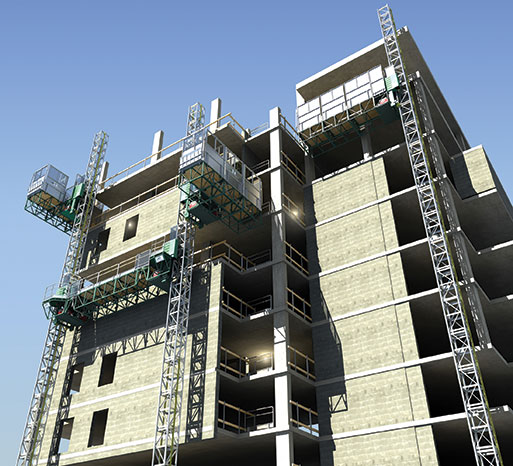Words: Kevin O’Shea, Hydro Mobile
The mast climber (MCWP) industry has been consistently working to highlight regulations and standards which MCWP owners and users should be aware of, and which govern and influence the safe use of the product.
MCWPs are very different to other forms of powered access.
For example, a scissor lift is delivered from the manufacturer with a fixed load capacity; an MCWP has various load characteristics depending on the configuration of the platform. Owners and users can change platform length and shape, and each time a change is made the capacity potentially changes.
It is therefore vital for owners and users to be aware of what regulations, design standards and manufacturers’ restrictions require to ensure safe use of the product, and to protect themselves from accidents, liability, and prosecution.
Regulation begins with OSHA. OSHA determines that an MCWP is a ‘Supported Scaffold’. However, unlike other types of supported scaffold which have separate designations and safe use requirements, MCWPs do not.
Equipment owners and users therefore have a combination of safe use criteria to comply with.
Top line regulations are best described as OSHA Supported Scaffold regulations which can be applied to MCWPs, followed by requirements from both the ANSI Standard and manufacturers requirements.
This can create confusion, which can lead to owners and users making the wrong choices.
OSHA REQUIREMENTS
OSHA’s scaffold regulations place the onus on the employer to provide a safe place of work for employees. OSHA’s 5(A)1 clause states: “Each employer shall furnish to each of his employee’s employment and a place of employment which are free from recognized hazards that are causing or are likely to cause death or serious physical harm to his employees.” The OSHA act therefore requires safe employment (i.e. work processes require to be safe) as well as a safe worksite (i.e. the place of employment must be safe).
When a user or owner measures up a job it’s primarily for commercial purposes.
Taking mast climbers as an example (and supported scaffold falls into the same category) they, through a job walk process, or by looking at blueprints, or both, decide on the position of drive units, where the tie backs will be, and how many are required, what configuration(s) and capacity they need, decide on whether units will be single units or ‘bridged’ units etc.
This produces a price for the project.
However this is also the beginning of the planning process, and part of this process requires the assessment of potential risks and hazards, which is the requirement of OSHA’s 5(A)1 clause.
When there is an accident on the machine, the voyage of discovery begins.
Who measured and planned the job?
Who identified the existing and predictable hazards?
Some of those hazards are mitigated by following OSHA Supported Scaffold regulations, the general requirements which exist for all types of supported scaffold.
They will define requirements for hazard identification, stability, training, inspection, fall protection, supervision, owner/user responsibility.
When OSHA does not cover all aspects, the regulatory requirements fall to both the ANSI Standard for MCWP’s (A92.9) and the manufacturers requirements for safe use.
These sources augment the OSHA requirements.
They provide essential guidance which owners and users must be aware of.
Examples include:
TRAINING
ANSI (American National Standards Institute) A92.9, the current design standard for MCWPs demands that “training on proper use and operation be given upon each delivery by sale, lease or rental.” Manufacturers require operators and installers of MCWP’s to be trained to a minimum standard.
CONFIGURATION AND ASSOCIATED CAPACITY
Operators and installers need to be aware of point load restrictions, eccentric load restrictions, uniformly distributed load capability and the need to know the weight of whatever they are loading onto the platform. This can vary from MCWP to MCWP depending on configuration.
FALL PROTECTION
There have been a number of accidents over the last 2-3 decades caused by guardrail removal, insubstantial planking and the presence of trip hazards on the platform.
Operators need to be aware of all fall protection issues in the platform, and need to be trained in the use, maintenance and inspection of any required fall protection equipment required on the platform.
INSPECTIONS AND TESTING
Equipment owners and users are mostly unaware of all the inspection requirements placed upon them. Daily, frequent (3-monthly) and annual inspections are required, with relevant documentation and record-keeping requirements, and those who conduct the inspections must be qualified to carry them out.
ERECTING AND DISMANTLING
In-depth product-specific training for those who erect and dismantle MCWP’s is a MUST.
The best way for owners and users to ensure the quality and suitability of this training is by working with the manufacturer of the MCWP.
Manufacturers offer robust training programs, and when owners and users have employees who are manufacturer trained AND certified they hugely reduce the potential for unsafe use and greatly improve their protection against liability.
HELP IS AVAILABLE
MCWP regulations and requirements are not all in one document, they are derived from OSHA, ANSI and the equipment manufacturer, and this can cause confusion.
Remember that MCAA members and committees are a valuable source of support, information and advice. There is a huge amount of information, best practice advice and training out there, using it will help improve safety, productivity and profitability.
